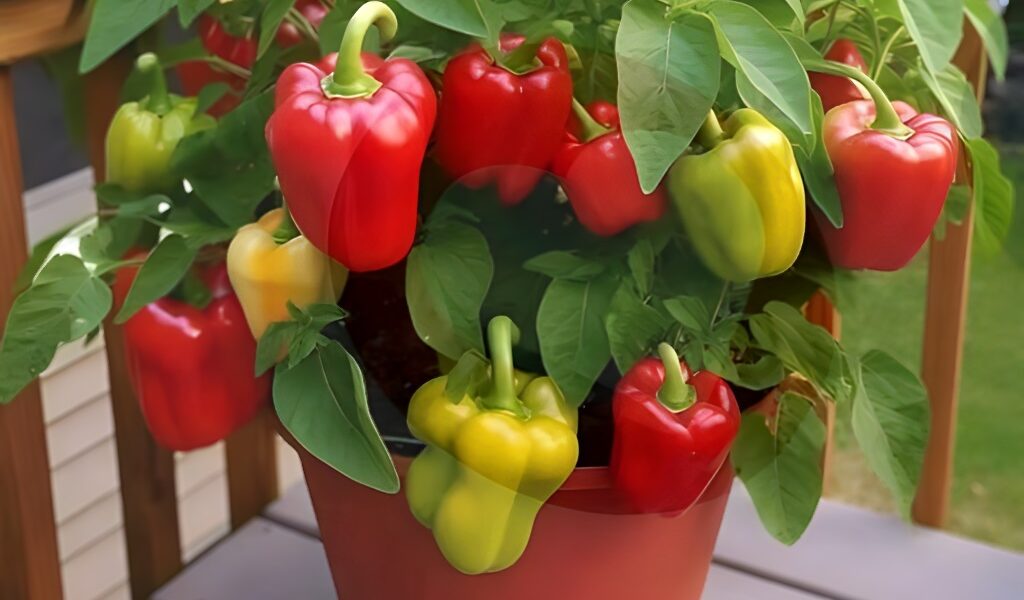Growing Peppers: The Key Steps to a Bountiful Harvest
Do you dream of tasting fresh and tasty peppers, picked directly from your garden?
Then this article is for you! Follow this complete guide to learn how to successfully plant and grow peppers and become a true expert on the subject.
1. Choose the varieties of peppers that suit your needs
First of all, before you start growing peppers, it is essential to choose the variety or varieties that best suit you.
In fact, there are many varieties of peppers with varied characteristics, both in terms of flavour, shape, size and colour. Generally, a distinction is made between sweet peppers, ideal for salads and Mediterranean cuisine, and hot peppers or chillies, used to flavour dishes.
READ: Growing Celery Like an Expert: Practical Tips for Successful Cultivation
So, depending on your desires and culinary needs, you can choose varieties such as the California Wonder pepper , which is very widespread and appreciated for its thick, juicy flesh, the Marconi pepper , which is elongated and ideal for grilling, or the Espelette pepper , which adds a spicy touch to your preparations.
2. Preparing pepper seedlings indoors
The first step to successfully growing peppers is to sow seeds indoors , usually between February and April.
In fact, peppers need heat to germinate and develop, and the ideal temperature is around 25°C. Here’s how:
- Fill buckets or trays with lightly compacted seedling soil.
- Place your pepper seeds on the surface of the potting soil, spacing them about 2cm apart.
- Cover the seeds with a thin layer of potting soil, then water gently with a sprayer.
- Place your seedlings near a heat source (radiator, hot greenhouse) and in the light, taking care to maintain a constant temperature and sufficient humidity.
After 2 to 3 weeks, the pepper seeds should germinate and the first sprouts will appear. Don’t hesitate to transplant them individually into larger pots if they are too narrow, taking care to handle them delicately so as not to damage the roots.
3. Transplanting peppers outdoors
Once the risk of frost has passed, generally from mid-May, you can transplant your pepper plants outdoors, either directly into the ground or into containers or pots on your terrace or balcony.
Here are some tips to successfully complete this crucial step:
- Choose a sunny spot protected from the wind, as peppers need warmth and light to develop properly.
- Prepare the soil by enriching it with compost or well-rotted manure, then loosen it with a pitchfork or gralineta.
- Space your pepper plants about 50cm (20 inches) apart in all directions, to give them plenty of room to grow and flower.
- Water your pepper plants well after planting to promote rooting and combat transplant stress.
If you grow your peppers in pots, be sure to choose containers that are at least 30cm in diameter and depth, and fill them with a mixture of potting soil and compost.
4. Maintain and care for your pepper plants
The success of your pepper crop also depends on good maintenance throughout the season.
Here are some essential steps to take to care for your plants and ensure their proper development:
- Watering: Peppers need cool, moist but not soggy soil. Water regularly, being careful not to wet the leaves to avoid disease. In warm climates, mulching with straw, grass clippings, or wood chips can be beneficial to keep the soil moist.
- Stake: To prevent your pepper plants from falling over due to the weight of the fruit, don’t hesitate to tie them to stakes or support them with nets or cages.
- Removing suckers: To encourage fruiting, it is advisable to remove suckers, these small side shoots that appear between the main stem and the branches. Simply pinch them off with your fingers or cut them off with a clean, disinfected pruner.
- Pruning plants: At the end of the season, do not hesitate to prune the ends of the branches of your pepper plants, to stimulate the ripening of the last fruits and make them easier to harvest.
Finally, to prevent diseases and pest attacks, take a preventive approach by encouraging biodiversity within your garden (hedges, honey-producing flowers, insect hotel) and ensuring the good health of your plants (watering, fertilization, aeration).
5. Harvest and store your peppers
Peppers are usually harvested between July and October , when the fruits have reached their final size and colour.
To do this, simply cut the peppers with pruning shears, keeping a small piece of the stem. You can then store them for a few days at room temperature or place them in the refrigerator for longer storage.
If you want to store your peppers for the winter, you have several options:
- Freezing: Wash, seed and cut the peppers into strips or cubes, then place them in freezer bags.
- Storage in jars: Prepare sterilized jars and fill them with peppers cut into strips, then cover with olive oil and some herbs (garlic, thyme, bay leaf).
- Drying: Cut your peppers into thin strips and dry them in the sun, in a dehydrator or in the oven at a low temperature, then store them in an airtight jar.
By following these tips, you can enjoy your peppers all year round, and add a colorful and tasty touch to your dishes.
In conclusion, planting and growing peppers is not an insurmountable task, as long as you follow the key steps and adopt good practices. So don’t hesitate any longer, embark on this adventure and savour the pleasure of tasting your own peppers, freshly picked from your garden!
